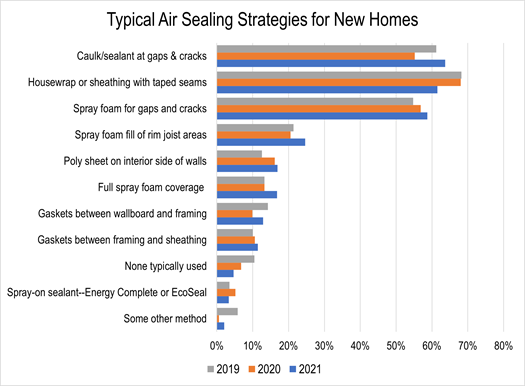October 27, 2022
Sealing the Deal: Trends in Air Tightening of the Building Envelope
As energy codes have become much more stringent on building airtightness, builders and building products manufacturers have scrambled to develop and incorporate new systems and methods to meet the needs. Three years ago, Home Innovation Research Labs introduced the Annual Builder Practices Report for Air Sealing to keep track of what builders were doing in the quickly evolving area. As part of the data-gathering for this report, we’ve asked builders this question in our annual survey:
Q. On your typical home, which of the following air sealing materials and methods did you use for above-grade walls, ceilings, and floors?
(exclude duct sealing)
About 1,300 home builders responded each year. The chart below summarizes their replies.

Source: Home Innovation Research Labs’
Annual Builder Practices Reports
The findings of the current Builder Practices Survey show the most common method of envelope air sealing is Caulk/sealant at gaps & cracks, used on about 64% of homes 2021, rising from the #2 position it held in the previous two years. The #2 spot is held by Housewrap or sheathing with taped seams with 62% of builders reporting it on their typical home — this held the #1 position in the prior 2 years. In the third position, accounting for 59% of homes in 2021, was Spray foam for gaps and cracks, which has steadily increased in popularity over the past three years.
Full cavity fills with spray foam have also experienced some increased popularity. For example, Spray foam fill of rim joist areas is now reported on 25% of new homes, up from 21% over the past two years. Full spray foam coverage of wall, floor, or roof cavities has also grown from 13% of homes to 17% of homes during this period.
Some other innovative methods — such as gasket products or spray-on sealants — have been making inroads in the past decade but are still used on a minority of homes.
One finding within this data was particularly remarkable:
The share of builders answering “None” dropped from 10% to 5% over the past 3 years! Meaning more and more builders have stopped relying on just sheathing, wallboard, or insulation materials to prevent air infiltration.
We also found that it’s no longer just “one-and-done” for air sealing – builders are not using just one air sealing practice on their homes. This year’s study shows that the average number of methods used on a typical house is just under 3.
You may be asking… is that all?!
My answer is, NO! This is just a glimpse of the findings from our 2022 Builder Practices Survey. We’ve also determined how air sealing strategies differ by geographic area, type of home (single vs. multifamily), size of builder, and price point of homes built from this study.
Top building product manufacturers have used Home Innovation's survey data for over 25 years to determine market demand and identify trends like these in the building materials market. The Builder Practices Reports cover building products installed on new homes and can be paired with our annual Consumer Practices Reports to give you a complete view of the residential building materials market.
Builder Practices Reports span the following categories:
- Appliances
- Attic Access
- Bathroom Accessories & Tub or Shower Doors
- Beams
- Cabinets for Kitchen & Bath
- Cement Usage
- Countertops
- Deck & Porch Railings
- Driveways
- Ducts
- Exterior Doors
- Faucets
- Fences & Landscape Walls
- Finish Flooring
- Fire Sprinkler Systems
- Foundations
- Garage Doors
- Headers
- Home Electronics
- Home Mechanical Ventilation
- Home Standby Generators
- House Wrap & Radiant Barriers
- HVAC Systems
- Infrastructure
- Insulation
|
|
- Interior Doors
- Interior Finish Materials
- Lighting
- New Housing Characteristics
- Outdoor Structures
- Patio Doors
- Plumbing Fixtures
- Plumbing Piping
- Radiant Floor Heating
- Roofing
- Roofing Underlayment
- Sheathing - Floors
- Sheathing - Roofs
- Sheathing - Walls
- Siding or Exterior Finish
- Soffit, Fascia, & Exterior Trim
- Structural Systems - Floor
- Structural Systems - Roofs
- Structural Systems - Walls
- Swimming Pools
- Underlayment
- Vapor Retarders in Walls & Ceilings
- Windows
|
We also provide more data format options now than we ever have before. The large survey sample size allows data subscribers to get a very granular look into county, metro area, state, and regional markets for new construction. This year, Builder Practices Reports are available in both tabular and database formats, giving you more analysis options, including analysis via business analytics and mapping software like Power BI and Tableau.
Interested in getting the details on your product categories?. Get in touch to learn more about how you can better monitor the market for construction products with this report series.
Back to Top